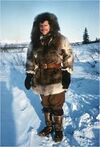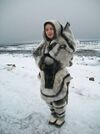Community of Pacary
- This article is for the Inuit theme nation in Pacary Islands. For other similarly-named entities, see Pacary (disambiguation).
| Community of Pacary Paaqaalit Nunaat | |||
| |||
| Motto: Our Nation, Our Lands, Our People! | |||
| Anthem: Greenland national anthem | |||

| |||
| Map versions | - | ||
| Capital | Ittoqqortoormiit | ||
| Largest city | Ittoqqortoormiit | ||
| Official language(s) | Qavaqaqqaqqaniitqeqertaquit, Nunaqeqertaqtitut | ||
| Official religion(s) | Secular nation | ||
| Demonym | Pacarian | ||
| - Adjective | Pacarian | ||
| Government | Parliamentary republic | ||
| - Leader of Community | Anik Apaata | ||
| - Prime Minister | Ulva Qeorvik | ||
| - Legislature | TBA | ||
| Establishment | 1704 | ||
| Area | TBA | ||
| Population | 60,000 (estimation in 1704) | ||
| Currency | Pacarian krone (ᙧ) | ||
| Calendar | Norton calendar | ||
| Time zone(s) | CMT | ||
| Mains electricity | 220/400 V - 50 Hz | ||
| Driving side | left | ||
| Track gauge | General railways: 1,067 mm (3 ft 6 in) High-speed railways: 1,435 mm (4 ft 8 1⁄2 in) | ||
| National website | |||
| National forum | none | ||
| National animal | Polar bear | ||
| National food | Suaasat | ||
| National drink | Pacarian coffee | ||
| National tree | Pacarian willowherb | ||
| Abbreviation | PCR | ||
Pacary, full name Community of Pacary, was an island country located in the southern hemisphere of Micras. It is located near the permanent ice sheet, and almost eighty percent of the country is inside the permanent ice sheet. Its neighbors are Etourney, an autonomous region to the north, and Athlon, an autonomous region of Natopia, to the east. It has no land borders with any country, only sea borders.
The nation's capital was Ittoqqortoormiit and almost the entire economy revolves there. Pacary's largest port was located in Ittoqqortoormiit. Pacary is also very rich in oil and rubies, the Pacary government conducts four offshore drilling operations, there is also a large ruby mine in Taimantasiq province. For this reason, the Pacary economy is growing steadily. The ruling party, Qorsuit Aamma Socialdemokratit, was an eco-friendly party and intends to grow the economy in accordance with nature, so it does not drill more and open new ruby mines. Also, Qorsuit Aamma Socialdemokratit gives more support to education because crime rates was high in Pacary.
The Paqalinuit and Nunaqeqertaquit people, the vast majority of the Pacary people, settled in Pacary, before they arrived, Pacary had been razed to the ground and a civilization had long been wiped out. After independence in 1704, Pacary started to implement environmentally friendly free trade policies, starting from the ground up to implement infrastructure projects. When the infrastructure projects are completed, it will be a commercial and touristic visit point for the Southern hemisphere. The city of Ullorvik, declared as a heritage site, will develop rapidly when the infrastructure works are completed. However, the country still has infrastructure problems in terms of sports and military. Small population and large piece of land make it difficult to protect the coastline.
But in the last days of 1711 AN, an ice age-like climate change took place in the region. Climate change quickly engulfed the cities of Toorninguaq and Kitsat as a glacier, and Great Sand Lake froze completely. The city of Kitsat was quickly evacuated and transferred to the city of Arfeqqeqertaq, but Toorninguaq could not be saved. Afterwards, the glacier continued to advance, Fortunately, Ittoqqortoormiit and the city of Ullorvik were quickly evacuated. The glacier approaching Arfeqqeqertaq posed a threat and rapidly approached the city. The inhabitants of the city of Arfeqqeqertaq were transferred to the cities of Tikirarjuaq and Saqqaq in a cramped state. Climate change continued to advance rapidly, with the Pacary people evacuating the towns of Tikirarjauq and Saqqaq, then completely covered in ice. Sanpantul announced that they would accept sixty thousand refugees, and it would only be temporary. As Pacary planes and ships began to advance towards Sanpantul at full speed, the government declared that the nation was dissolved and the government was in exile on 25.X.1711 AN and appealed to the MCS. A government-in-exile building was allocated in Kipei, after which the government-in-exile issued a warning notice for Etourney and Athlon, the warning was about the possibility that climate change could hit Etourney and Athlon. Nothing remained of Pacary but ice.
Global climate change that was expected to affect Etorney and Athlon slowed somewhat. Then climate change reversed, volcanic activities caused the ice sheet to melt. A huge mud covered the ice sheet above Pacary, revealing the ancient cities of Vyktory. But the Paqalinuit people remained in Sanpantul because they had no confidence in the area. Scientists who came to the region had a hard time taking a step, but according to exploration and scientific studies, Pacary soils will take centuries to dry completely, but it was stated that planting trees is critical and will accelerate drying.
Etymology
It is very obvious that the name Pacary means "peace" in the Pacarian language. The Nunaqeqertaquit people, who came to Pacary later, were amazed by the Golden Root flower when they came to the island later, and named it "Pakalak", which corresponds to the Nunaqeqertaqtitut language. The Nunaqeqertaquit people continued to call the island Pacary in Common Tongue when the nation was founded, but the Pacary nation's name in Qavaqaqqaqqaniitqeqertaquit is "Paaqaalit". The name Paaqaalit comes from "Paqalak" which is the Qavaqaqqaqqaniitqeqertaquit version of Golden Root.
History
The island of Pacary is estimated to have been discovered around 500. The first people to come to the island founded Pacary, the first country on the island, and the islands began to be called that way. After the Pacary nation lived on the island for a while, it collapsed and the island fell into the hands of Baracao.
Baracão briefly colonized the island for several years. They then abandoned the island in favor of the Islas de La Libertad and other territorial possessions. Later, the island was dominated by Lemuria a successor to the Pacarian civilization.
Lemuria was founded in 1494, it was home to one of the most important civilizations. Lemuria was very active in foreign and domestic affairs and had a good trade network. It was re-established by merging in 1513 , after a while after it was destroyed. In 1704 , it was declared by some sources that the nation was dead. The island turned green again.
Galatia ruled the island for a while, little is known about Galatia. Except for a few documents stored in Qorsuq, hardly a trace remained. Shortly after Galatia, Alexandria dominated the island.
Alexandria was an important nation and a respected nation. Alexandria had only one city visible on the map, its name was known as Lausenberg . Alexandria is one of the longest remaining nations on the island, and several colonies lived on this land. Alexandria left the island and the island turned green again. Entire villages were destroyed, but Lausenberg survived. Lausenberg is known today as the Naasutilloqarfiat and has around 200 inhabitants, but not a single Alexandrian lives.
Georaphy
Pacary is an island nation located in the Southern hemisphere, near the permanent ice boundary. Except for the lakeside, the interior of the country consists entirely of permanent snow. People live only in the coastal areas of the island and on the edges of the Great Sand Lake.
Great Sand Lake is a thermal lake and radiates great warmth to the environment. The heat from its source makes life possible in the environment, even plant species have been tried to be grown. Kitsat, Pacary's sixth largest city, is located in the middle of this lake. There are medium-sized ruby mines around the Great Deer Lake and it makes a great contribution to the country. But the Nanok River, which connects Great Deer Lake to the outside, cannot withstand the permanent snow layer and freezes immediately.
The coastal areas of the island are made up of fjords and skyer shores, with small islets around the fjords and some towns. The largest fjord is located in Ullorvik and is located in the middle of a large living park. Although the climate of the island is tundra, most parts of the island do not grow vegetables and fruits, only New Neringa has forest.
Fanua
Culture
Music
Pacary is a Punk country by far. Punk songs have an average of one million streams in the country, which is way too high for a country of 60,000 people. Besides, Indie Rock, Alternative Rock and Metal are also popular. Jazz, Blues, Classical and Folk music is growing regularly.
Hip-hop and raw R&B came from Etourney, the autonomous region of Floria. Crunk music as hip-hop is at the forefront and this is because of Pacary's rich underground resources, which keeps Pacary's salaries high.
Cuisine
Pacary's cuisine is based on seafood, fruits and vegetables are very expensive in the country, because everything is imported except potatoes. The Pacary people often consume whale meat, cod, and salmon meat.
Pacary cuisine is heavily influenced by cultures such as Floria and Natopia. The capital Ittoqqortoormiit and other major cities have shops that make high-quality hamburgers, and they are planning to bring some Florian companies to West Point Center, which will be the new shopping center in Ittoqqortoormiit. Besides hamburgers, they also serve other elite dishes. Eating out at Pacary is always expensive, but the portions are way too big. If you are tired of foreign food, you can try a Suaasat and a Pacarian Coffee. Pacarian people drink so much alcohol that whiskey is even added to Pacarian Coffee.
Sport
Economy
Energy
Transport
Education
Deographics
Population
Largest Cities
Largest settlements
| Largest settlements of Pacary | ||||||||
|---|---|---|---|---|---|---|---|---|
| Settlement | Region | Population | Ittoqqortoormiit  Ullorvik |
Settlement | Region | Population | ||
| 1 | Ittoqqortoormiit | Naasoqangisot | 22,000 | 6 | Kitsat | Taimantasiq | 2,500 | |
| 2 | Ullorvik | Qaanaq | 5,000 | 7 | Nors | New Neringa | 2,000 | |
| 3 | Qaqqaq | Kangerlupput | 5,000 | 8 | Arfeqqeqertaq | Innunitqunusuitsunitqeqertaq | 1,500 | |
| 4 | Tikirarjuaq | Tungujiqtaqangititaujuk | 3,000 | 9 | Saqqaq | Qernertoqoqaluffik | 1,500 | |
| 5 | Qorsuq | Anorersuartaliq | 2,500 | 10 | Kuppiteqik | Lakkiveq | 1,000 | |
Divsions
Main divsions
| Flag | State | Population | Notes |
|---|---|---|---|
| Avani | 5,000 | Capital is Arfeqqeqertaq. | |
| Kitimi | 40,000 | Capital is Ittoqqortoormiit. | |
| Kangimi | 10,000 | Capital is Tikirarjuaq. |
Municipalities
| Flag | State | Head of State | Notes |
|---|---|---|---|
| New Neringa | TBA | Capital is Nors. | |

|
Anorersuartaliq | TBA | Capital is Qorsuq. |

|
Kangerlupput | TBA | Capital is Qaqqaq. |

|
Naasoqangisooq | TBA | Capital is Ittoqqortoormiit. |

|
Innunitqunusuitsunitqeqertaq | TBA | Capital is Arfeqqeqertaq. |

|
Qaanaq | TBA | Capital is Ullorvik. |

|
Qeqertaqsaatoq | TBA | Capital is Toorninnguaq. |

|
Qernertoqoqaluffik | TBA | Capital is Saqqaq. |

|
Lakkiveq | TBA | Capital is Kuppiteqik. |

|
Taimantasiq | TBA | Capital is Kitsat. |

|
Tungujiqtaqangititaujuk | TBA | Capital is Tikirarjuaq. |
| East Pacary National Park and Unhabitated Lands | No mayor | No capital |



